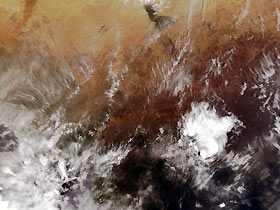
Save this image free of charge
in 800 pixels for layout use
(right click, Save as...)
|
|
Ref : V01378
Theme :
Fires - Dust - Pollution (seen from Space) (239 images)
Title : Fires across the Sahel
Caption :
Each year in March and April thousands of fires smolder in the grasslands, scrub, and dry forests of the West African Sahel and Soudanian woodlands. NASA spacecraft, captured this true-color image on March 2, 2001. Data from infrared detectors were used to locate areas where fires are burning, shown by red dots. The arid grasslands of the Sahel are to the north (top) of the image. The fan-shaped green area is Lake Chad. To the center and south of the region, in northern Nigeria, northern Cameroon and southern Chad, increasing annual rainfall results in the gradually increasing tree cover and darker appearance of the Soudanian woodlands. The Sahel of West Africa is of great importance to regional economies and human welfare. While water is always scarce in the Sahel, even during the brief rainy season between June and September, the grasslands provide high-quality grazing for domestic livestock (cattle, sheep and goats). Thus the human populations to the south rely on the Sahelian grasslands as summer grazing for their herds in a land use system known as transhumance. In this system, large numbers of animals travel north into the Sahel every year. The grasslands and woodlands of the Soudanian zone are less nutritious for domestic animals, but the higher rainfall allows more agriculture. Fire is used to clear new agricultural land and to improve grazing potential of the natural vegetation by removing dead grass and promoting new growth. Many fires in the Soudanian zone are also ignited by lightning strikes. During the long Sahelian dry season water supplies limit cattle numbers and many herds travel south again to winter on crop residues in the south. In so-doing they provide much-needed fertilizer to the fields. Fire has been used for centuries as a management tool in West African agricultural and pastoral systems. However, increasing human populations and food production requirements can reduce the length of fallow periods and increase the frequency of fire usage. In this situation, the benefits of fire as a management tool can be outweighed by the negative impacts of fire on soil fertility, leading to long-term declines in productivity.
|
|

